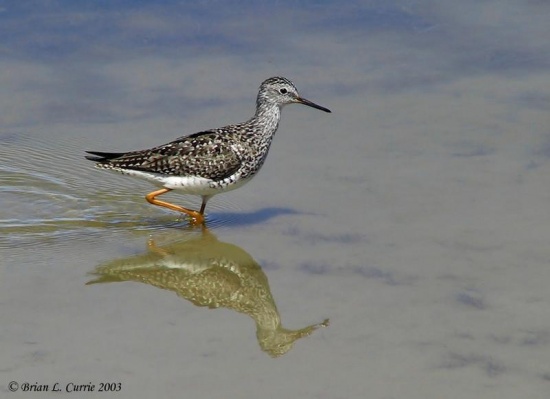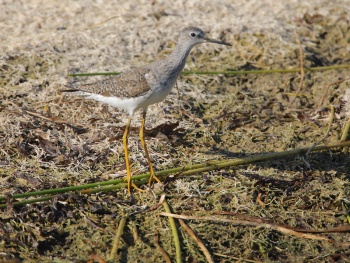Nomdeploom (talk | contribs) |
(Non-breeding & underwing pictures uploaded. Some extra information added and referenced) |
||
| Line 1: | Line 1: | ||
{{incomplete}} | {{incomplete}} | ||
| − | |||
[[Image:Lesser_Yellowlegs.jpg|thumb|550px|right|Photo by {{user|bcurrie|bcurrie}}]] | [[Image:Lesser_Yellowlegs.jpg|thumb|550px|right|Photo by {{user|bcurrie|bcurrie}}]] | ||
;[[:Category:Tringa|Tringa]] flavipes | ;[[:Category:Tringa|Tringa]] flavipes | ||
| − | |||
==Identification== | ==Identification== | ||
| − | + | 23-25cm<br /> | |
| + | *Bright long yellow legs in all plumages | ||
| + | '''Adults''' | ||
| + | *Upperparts grey-brown with white spotting | ||
| + | *Long, thin dark bill, which is virtually straight | ||
| + | *Underparts white | ||
| + | *Neck and breast have dark brown streaks | ||
| + | *The tail is white with darker barring | ||
| + | *Square white rump | ||
| + | *Very short supercillium | ||
| + | ====Similar Species==== | ||
| + | [[Image:608-03399fg Nonbreeding Lesser Yellowlegs.jpg|thumb|350px|right|Photo by {{user|bobsofpa|bobsofpa}}<br />Non-breeding<br />[[Loxahatchee National Wildlife Refuge]], [[Florida]], [[USA]], April 2008]] | ||
| + | Larger [[Greater Yellowlegs]]; [[Common Redshank]], which has red legs; [[Wood Sandpiper]] which may occasionally show yellowish (rather than green legs), but has a longer supercillium. | ||
==Distribution== | ==Distribution== | ||
| − | [[Canada]] and the [[United States]] | + | '''Breeds''' in [[Canada]] and the [[United States]]. |
| + | |||
| + | Frequent '''vagrant''' to [[Europe]], usually in the autumn; most records are from the [[British Isles]]. | ||
==Taxonomy== | ==Taxonomy== | ||
==Habitat== | ==Habitat== | ||
Marshes, mudflats, shores, and pond edges. In summer, open boreal woods. | Marshes, mudflats, shores, and pond edges. In summer, open boreal woods. | ||
==Behaviour== | ==Behaviour== | ||
| + | [[Image:LesserYLegs9-7-08.jpg|thumb|350px|right|Photo by {{user|onlybill|onlybill}}<br />[[Brazoria National Wildlife Refuge]], [[Texas]], [[USA]], September 2008 ]] | ||
| + | ====Flight==== | ||
| + | Trails feet in flight. Has a similar outline to [[Wood Sandpiper]]. | ||
| + | ====Breeding==== | ||
They nest on the ground, usually in open dry locations. | They nest on the ground, usually in open dry locations. | ||
| − | + | ====Diet==== | |
| − | + | Their main diet consists of insects, small fish and crustaceans which they gather from shallow water. They sometimes use their bill to agitate the water. | |
| − | + | ==References== | |
| + | #Wikipedia | ||
| + | #Collins Field Guide 5th Edition | ||
| + | #Collins Bird Guide ISBN 0 00 219728 6 | ||
==External Links== | ==External Links== | ||
{{GSearch|Tringa+flavipes}} | {{GSearch|Tringa+flavipes}} | ||
[[Category:Birds]] [[Category:Tringa]] | [[Category:Birds]] [[Category:Tringa]] | ||
Revision as of 12:07, 13 April 2009
| This article is incomplete. This article is missing one or more sections. You can help the BirdForum Opus by expanding it. |

- Tringa flavipes
Identification
23-25cm
- Bright long yellow legs in all plumages
Adults
- Upperparts grey-brown with white spotting
- Long, thin dark bill, which is virtually straight
- Underparts white
- Neck and breast have dark brown streaks
- The tail is white with darker barring
- Square white rump
- Very short supercillium
Similar Species
Larger Greater Yellowlegs; Common Redshank, which has red legs; Wood Sandpiper which may occasionally show yellowish (rather than green legs), but has a longer supercillium.
Distribution
Breeds in Canada and the United States.
Frequent vagrant to Europe, usually in the autumn; most records are from the British Isles.
Taxonomy
Habitat
Marshes, mudflats, shores, and pond edges. In summer, open boreal woods.
Behaviour
Flight
Trails feet in flight. Has a similar outline to Wood Sandpiper.
Breeding
They nest on the ground, usually in open dry locations.
Diet
Their main diet consists of insects, small fish and crustaceans which they gather from shallow water. They sometimes use their bill to agitate the water.
References
- Wikipedia
- Collins Field Guide 5th Edition
- Collins Bird Guide ISBN 0 00 219728 6





